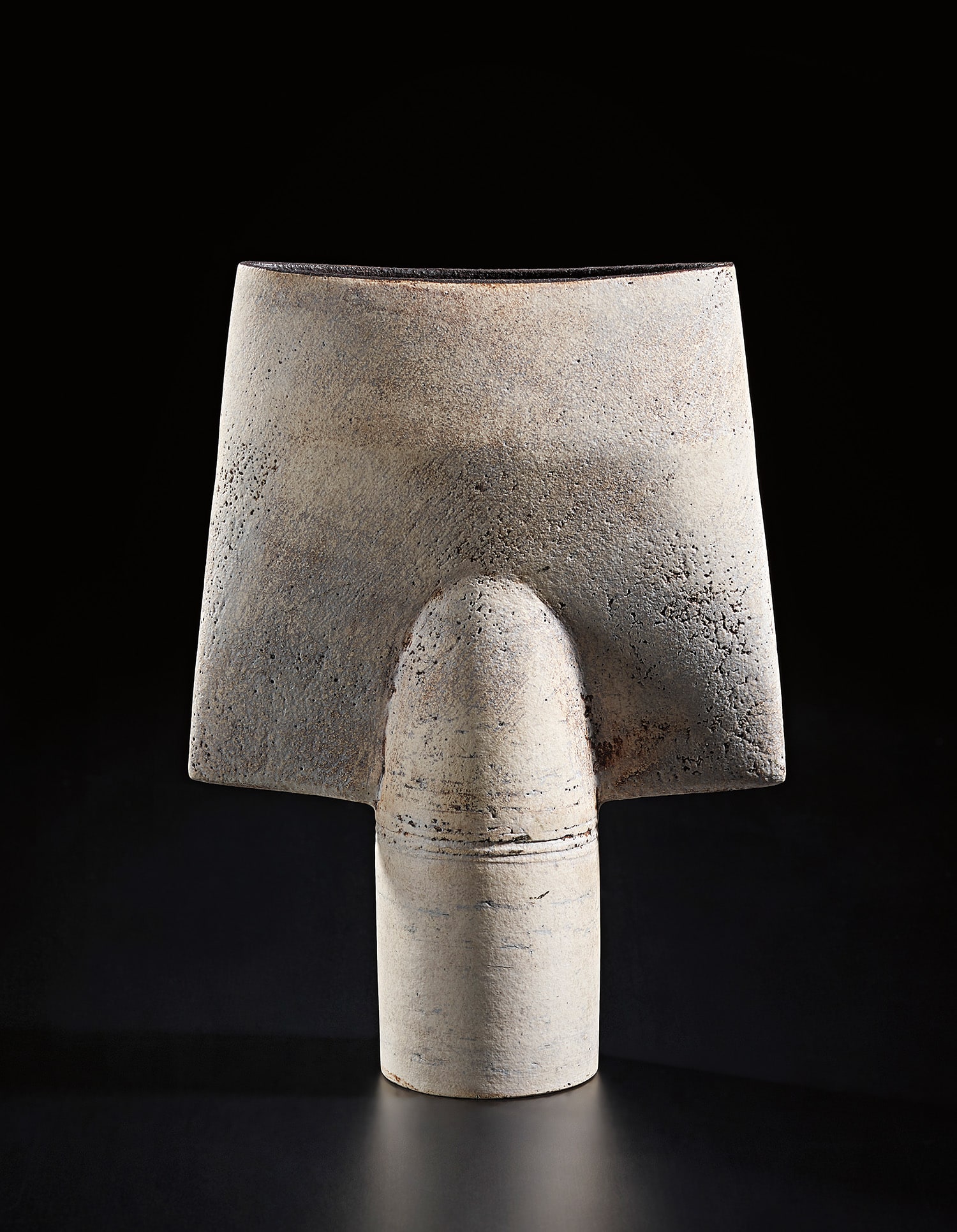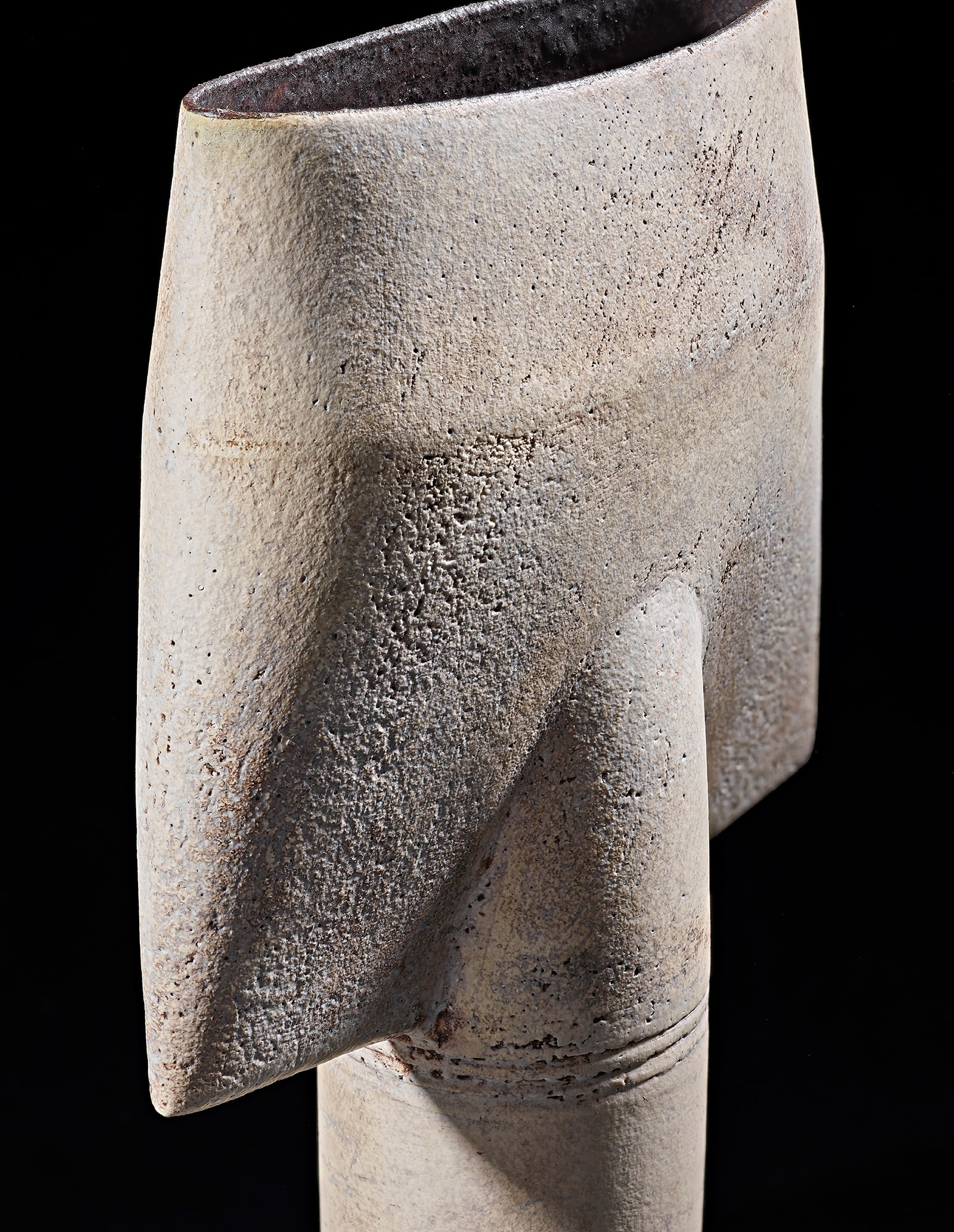



70
Hans Coper
Spade form
Full-Cataloguing
Coper’s pots have an austere look…Their shapes suggest primitive forms out of which the first sculpture might have grown. It can be no accident that the words which most readily rise to mind to describe their shapes are figurative: necked, beaked, cleft, waisted and so on. Their hollowness and flatness, fullness or slenderness…seems related, like all art that matters, to our own experience of ourselves or the world around us.
(Edwin Mullins, The Sunday Telegraph, February 1969)
Hans Coper’s work was about a gradual lifelong distillation of form, what he called 'concentrating on continuous variations of simple themes', working in batches to make sculptural shapes that were thrown, altered and assembled, objects that broadened the language of the wheel. He admired the work of Constantin Brâncuși and Alberto Giacometti in part because of their ability to express an essence. Their approaches to paring down and to the figure were very attractive to a potter who also wanted to achieve some level of simplicity. Coper’s tool would always be the wheel, but the superb spade and ‘Cycladic’ arrow pieces illustrated here show how he was able to stretch the vocabulary of throwing through inventive manipulation, of cutting and joining thrown sections.
The spade form featured in this sale (this example from 1972) was first developed in 1966 at Coper’s studio in Hammersmith, and first shown at his major exhibition with Lucie Rie at the Boymans Museum, Rotterdam the following year. It has been described as a ‘flattened envelope-like’ shape, with a narrow cylindrical base opening out into a broad flattened cylinder, like an abstracted head and neck. There were obvious references to the frontality and geometric contours of Cycladic figures and Egyptian sculpture, but the fact that they were still pots, having risen as vessels on the turning wheel, was important. Douglas Hill wrote (with Coper’s approval) in the catalogue for the Boymans show, 'In Coper’s work, one can see not so much a quality of serenity as a kind of balanced tension. Coper seems to be exploring the outward limits of pottery, and to be pushing those limits back with each motif.
The spade forms showed Coper’s continuing preoccupation with symmetry and balance, the sense of a piece having perfectly integrated components. In examining earlier and later variations of his pots, we realise how closely related each development is, here how the spade grew out of earlier stem pieces and cups, part of the same family as contemporaneous disc forms, hour glass shapes and the narrow forms on drum bases, the close ancestors of these two ‘Cycladic’ arrow pieces from the early 1970s (and made in his last studio, in Frome). With the spade the main broad section of the pot grows out of a thick stem, but Coper developed a technique which allowed him to narrow the base of the upper section of his most delicate pieces to a point. They were made to seem as if they were just balancing on their small drum or square bases. This was done by pinning the drilled sections together with a steel needle. As the ‘Cycladic’ arrows show, rarely has precision engineering in ceramics been used to such spectacular effect. It would be difficult to call these ‘pots’ as such, such is their expressive delineation.
Most of the shapes made in the last two decades of his working life clearly relate, amongst other influences, to early Mediterranean sculpture and artefacts, particularly that of the Cyclades. By the mid 1970s the anthropomorphic allusions to the human face and figure, very abstracted, were still clearly there. The two arrows conjure up ethereal groups of such pieces seen in his later exhibitions, particularly perhaps in a memorable show he had at Robert Welch’s gallery in Chipping Campden in 1975. Already ill, it was to be his penultimate show. The arrow pieces are wonderful feats not only of concentration, poise and balance, but carry an almost mysterious presence, votive and totemic, and sum up Hans Coper's lifelong obsession with, as he put it, 'extracting essences'.
- David Whiting
Hans Coper
German | B. 1920 D. 1981Hans Coper learned his craft in the London studio of Lucie Rie, having emigrated from Germany as a young Jewish engineering student in 1939. He initially assisted Rie in the studio with the ceramic buttons she made for the fashion industry, as well as ceramic tableware, but soon Coper was producing his own work. By 1951 he had received considerable recognition exhibiting his pots in the "Festival of Britain."
Coper favored compound shapes that, while simple in appearance, were in fact complex in construction. Similar to the making of Joseon Dynasty Moon Jars (Rie in fact displayed a Moon Jar in the studio), he would build his vessels by bringing several thrown forms together, for example joining bowls rim to rim. Coper eschewed glazes and preferred the textured surfaces achieved through the application of white and black slips, evoking the abraded texture of excavated vessels. This interest in ancient objects was very much in step with other modernists of his time—Coper admired Constantin Brancusi and Alberto Giacometti and his textured markings have been compared to sculptors such as William Turnbull.
In the last phase of his career, Coper reduced the scale of his work creating small "Cycladic" pots that stood on pedestals or drums, recalling the clay figures of Bronze Age Greece.